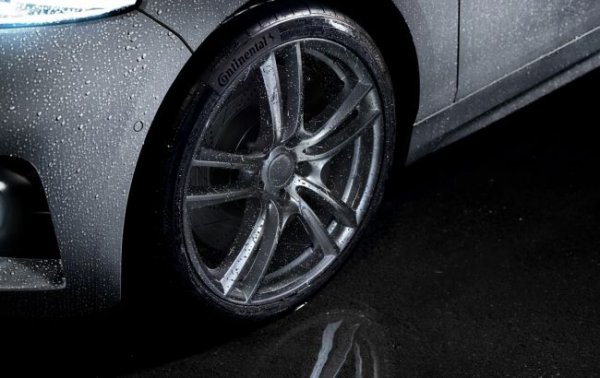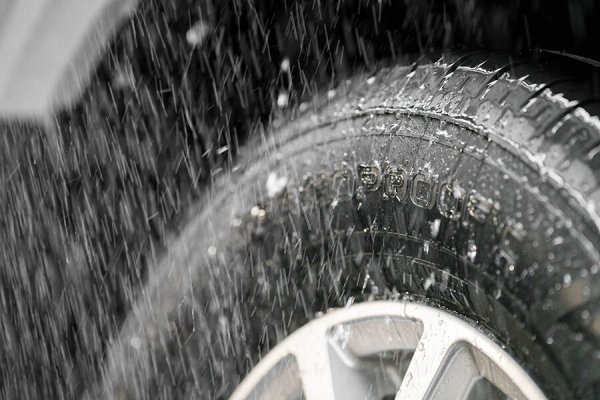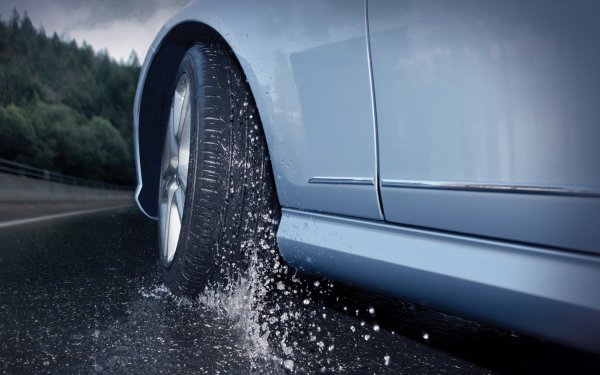
Photo: What are rain tires (continental-tires.com) Author: Konstantin Shirokun
When Formula 1 racing cars are fitted with rain tires, no one has any questions. But what about such tires for a family car? RBC-Ukraine Auto journalists tell when it is worth buying rain tires.
Read about the benefits of rain tires for cars in the RBC-Ukraine article.
What's wrong with the road in the rain
Road conditions in summer are most favorable for safe driving. But even in the warm season there are situations when it is difficult for a car to stay on the road: rain. And not just wet asphalt, but rain, when a thin but continuous layer of water remains on the surface, and where there is none, there are streams and puddles. In such conditions, the average motorist would also benefit from special rain tires – like those on racing cars.
And leading tire manufacturers responded by creating a separate category of summer tires – rain tires. The tread of which is designed for driving on a surface with a constant layer of water.

Why Rain Tires Are Better
The main difference between rain tires and regular summer tires is their increased resistance to aquaplaning – one of the most dangerous phenomena that a modern driver can encounter.
A car driving on a rain-soaked road pushes through a layer of water on the surface with its wheels and reaches the asphalt with its tread blocks. As a result, it clings to the road more or less successfully. But if the speed increases (or the amount of water on the surface increases), there will come a point when the tread blocks will not have time to push through the layer of water – and then the wheels float on a wedge of water, which they literally “turned” in front of themselves.
Consequently, the car loses control, because it has no contact with the road. And there is no point in turning the steering wheel or braking. Even an experienced driver cannot easily notice aquaplaning in time, and if the driver tries to change direction or speed during such gliding, the car can simply fly off the road. (The correct solution would be to simply release the gas so that the car slows down naturally and grabs the road with its tread).
So, along with the increase in the number of comfortable and fast cars, whose drivers prefer to drive without restrictions in any weather, leading tire manufacturers have come up with a design for summer tires for reliable handling in rainy weather. Depending on their marketing policy, some manufacturers position such rubber as tires for cool summers or for regions with difficult climatic conditions, while others simply call such tires rain tires.
Rain tire construction
In general, rain models are typical summer tires. They have the appropriate tread rubber composition; unlike winter models, they do not have thin sipes and large protruding blocks in the shoulder area. However, it is the tread that distinguishes rain tires from regular summer tires.
The main task of the designers in this case is to activate the drainage of water from the contact zone of the tire with the road. That is why the first thing that catches the eye in rain models is the wide longitudinal grooves for water drainage on the tread. Depending on the model and the width of the tire, there can be one or more, up to four. They are connected to each other or to the edges of the tread by deep channels, through which the water eventually quickly leaves the contact zone.
The second way to effectively remove water from under the tire is to divert it through wide V-shaped grooves in the center of the tread. The wheel with them gets a spectacular look from a design point of view, but on tires with a wide profile (from 225 mm) such a pattern becomes ineffective. In fact, these wheels should not be considered rain wheels, since at speed the water does not have time to leave the contact patch – it has to overcome too long a path from the center of the tread to its edges. It is clear that tires with V-shaped grooves, rain or not, will be classified as directional models.

Finally, rainy weather tires have another difference from regular summer tires – the rubber compound in them is selected in such a way that the wheel grips the wet road well. The tread groove also has corresponding features.
Short
Perhaps it would not be an exaggeration to talk about rain tires as a separate class, because there are quite a lot of them and they really make driving in the rain safer. The sense in them is seen by those drivers who need reliable grip of the wheels with the road in any summer weather, and in particular – in the most unfavorable, “wet” conditions.
Materials from Nokian Tyres and Rosava were used in preparing this article .
Recently, RBC-Ukraine reported what to do if you crash into a pothole on the road.
